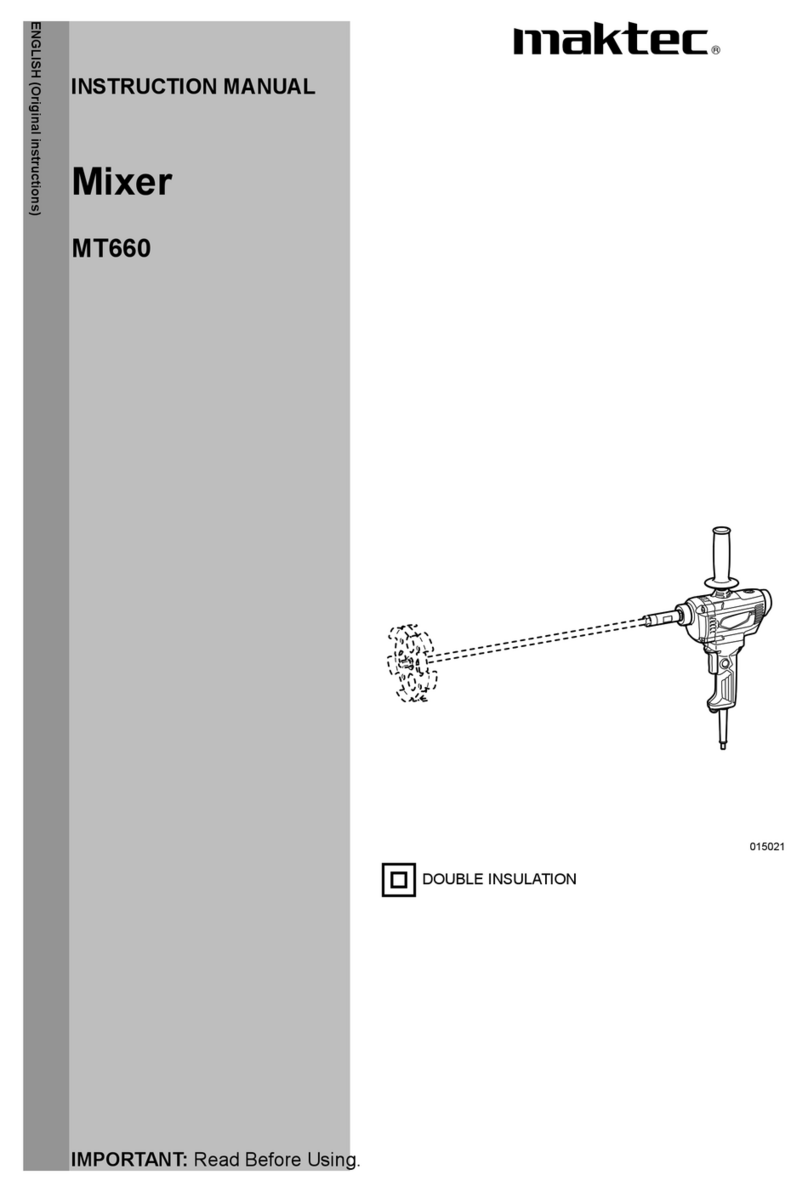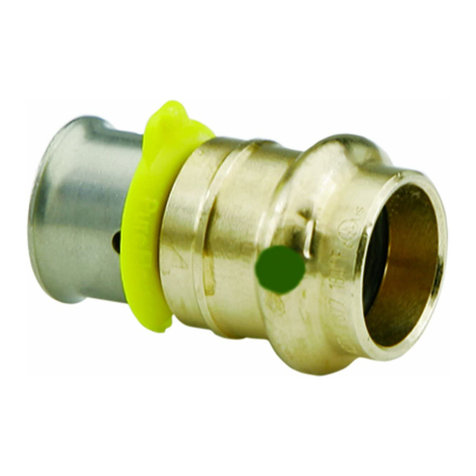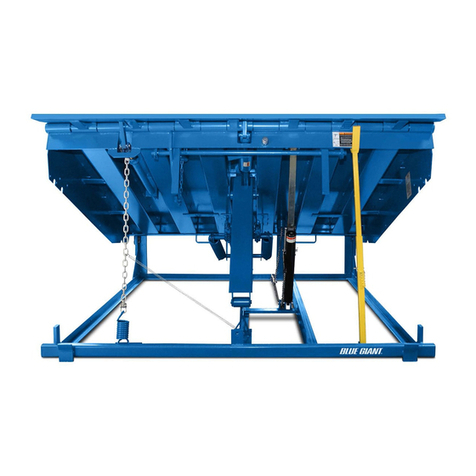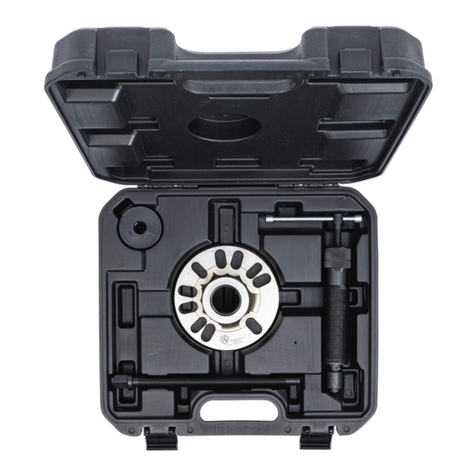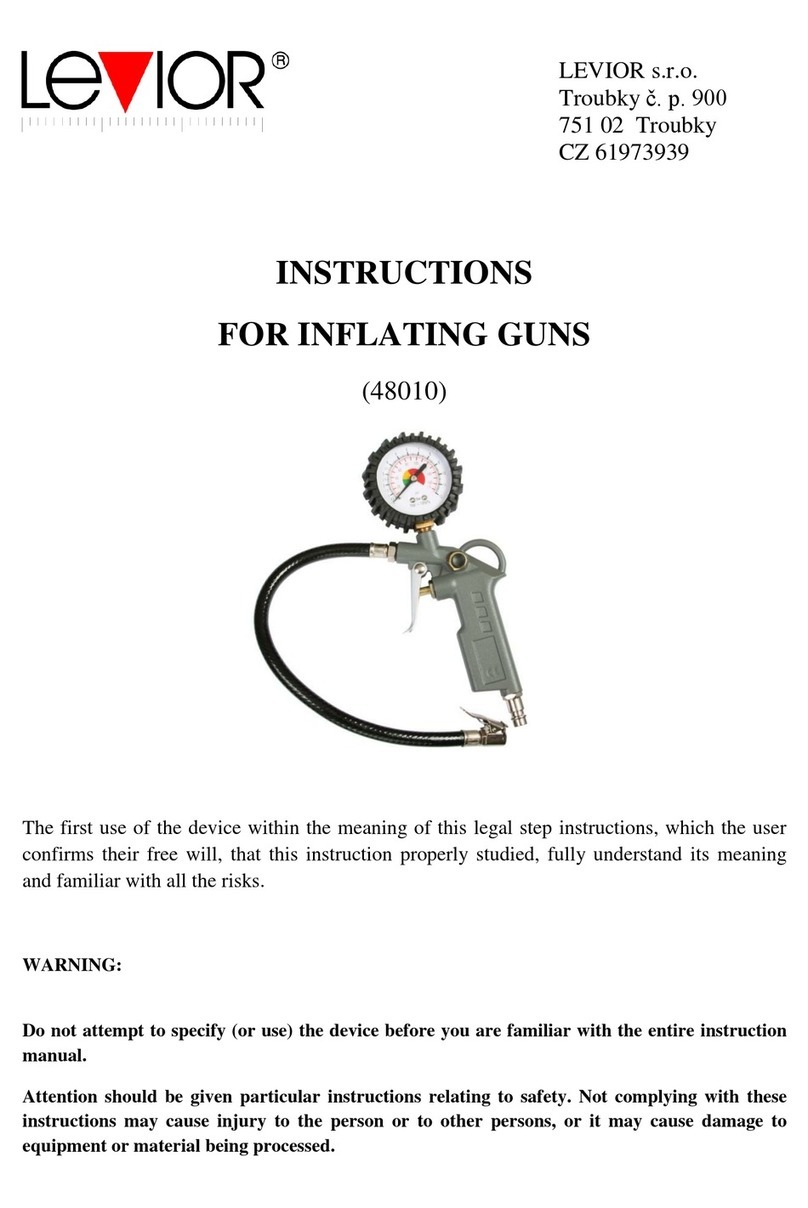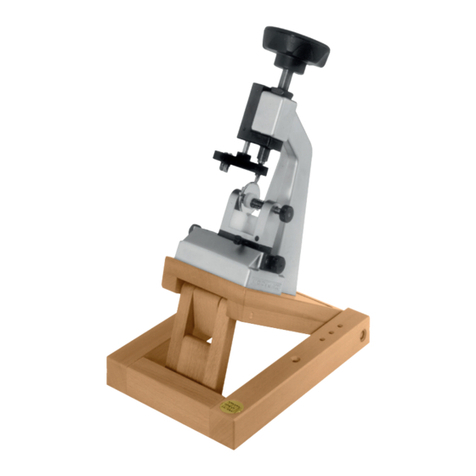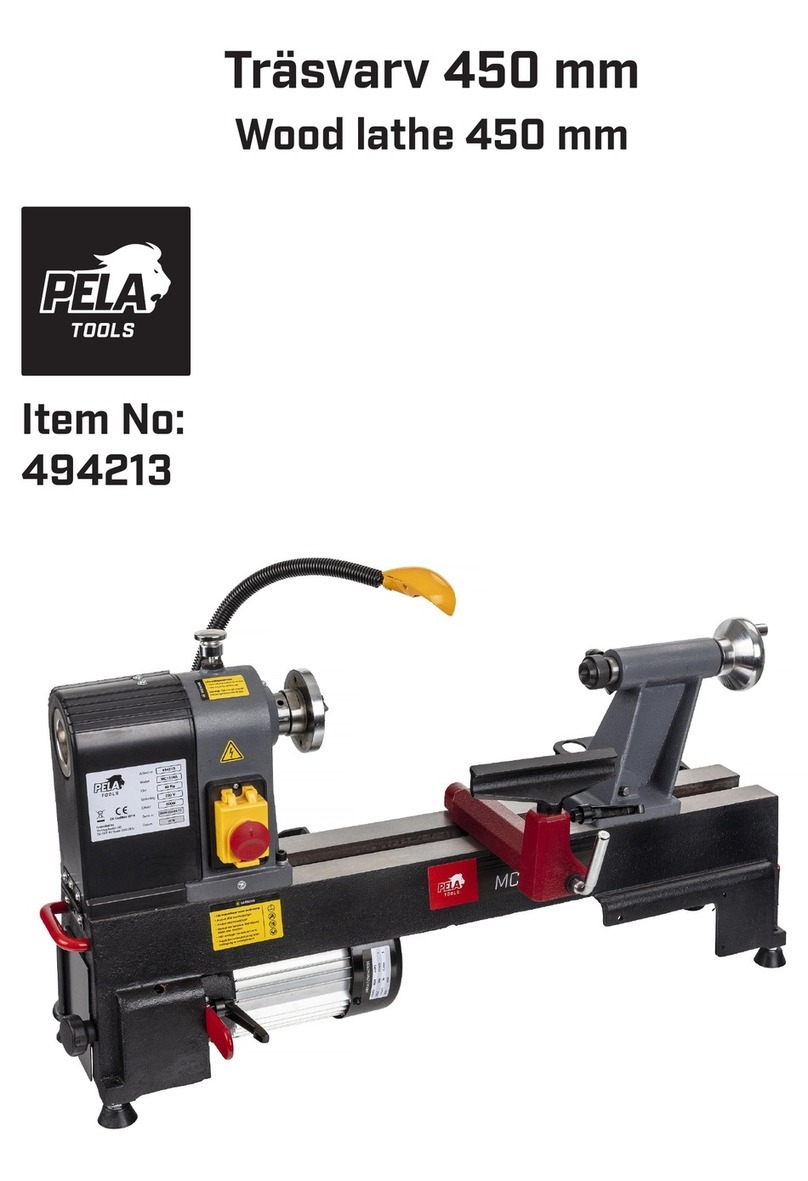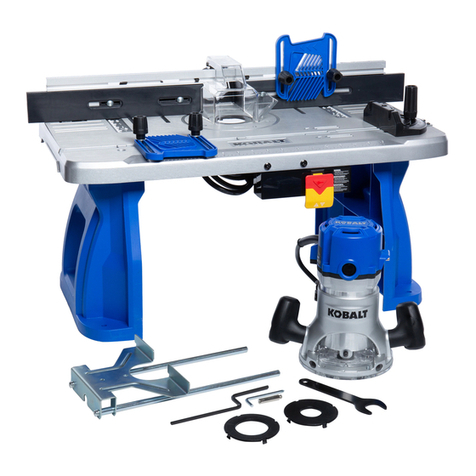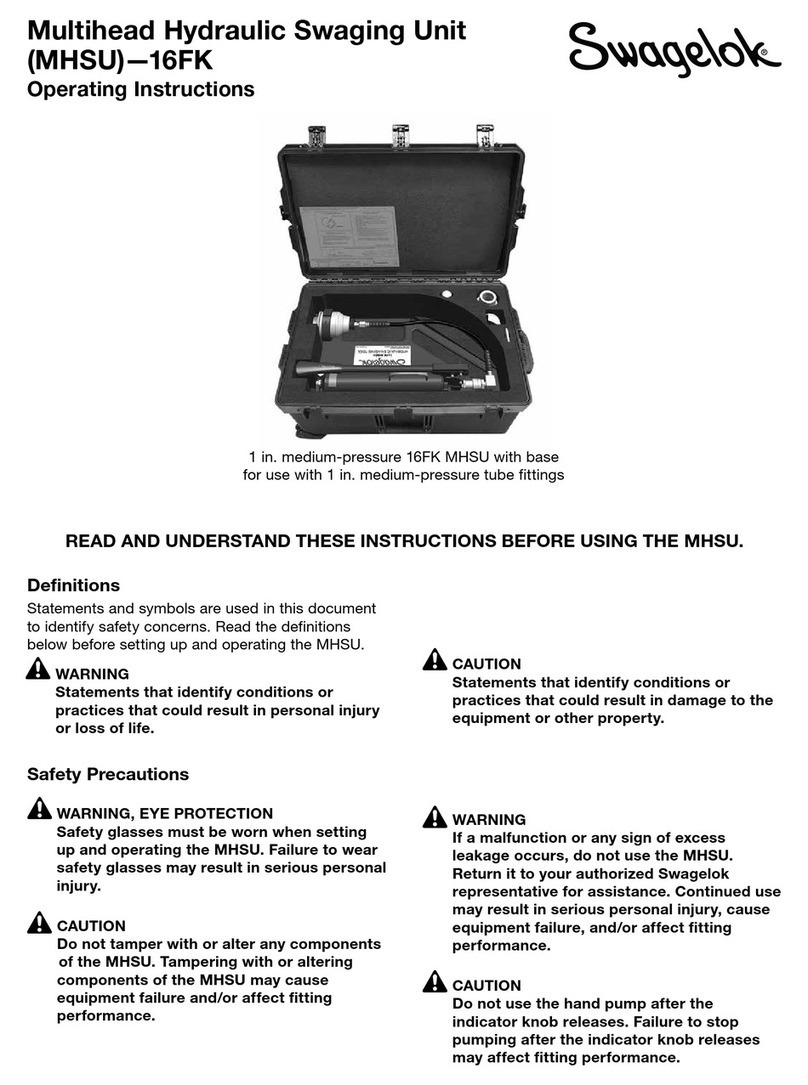Maktec MT871 User manual

MT871
EN Combination Hammer INSTRUCTION MANUAL 4
ID Bor Getar Kombinasi PETUNJUK PENGGUNAAN 9
VI
Máy Khoan Đa Năng Cầm Tay
Hoạt Động Bằng Động Cơ
Điện
TÀI LIỆU HƯỚNG DẪN 15
TH 20

1
2
Fig.1
1
B
A
Fig.2
1
Fig.3
1
Fig.4
1
Fig.5
2
3
4
1
Fig.6
1
2
Fig.7
1
Fig.8
2

1
2
Fig.9
1
Fig.10
1
2
Fig.11
Fig.12
Fig.13
1
Fig.14
1
Fig.15
3

4ENGLISH
ENGLISH (Original instructions)
SPECIFICATIONS
Model: MT871
Drilling
capacities
Concrete 26 mm
Core bit 68 mm
Diamond core bit (dry type) 80 mm
Steel 13 mm
Wood 32 mm
No load speed 0 - 1,200 min-1
Blows per minute 0 - 4,500 min-1
Overall length 362 mm
Net weight 2.7 kg
Safety class /II
• Duetoourcontinuingprogramofresearchanddevelopment,thespecicationshereinaresubjecttochange
without notice.
• Specicationsmaydifferfromcountrytocountry.
• Weight according to EPTA-Procedure 01/2003
Symbols
The following show the symbols used for the equip-
ment. Be sure that you understand their meaning before
use.
Read instruction manual.
DOUBLE INSULATION
Only for EU countries
Do not dispose of electric equipment
together with household waste material! In
observance of the European Directive, on
Waste Electric and Electronic Equipment
and its implementation in accordance with
national law, electric equipment that have
reached the end of their life must be col-
lected separately and returned to an envi-
ronmentally compatible recycling facility.
Intended use
The tool is intended for hammer drilling and drilling in
brick, concrete and stone as well as for chiselling work.
It is also suitable for drilling without impact in wood,
metal, ceramic and plastic.
Power supply
The tool should be connected only to a power supply of
the same voltage as indicated on the nameplate, and
can only be operated on single-phase AC supply. They
are double-insulated and can, therefore, also be used
from sockets without earth wire.
SAFETY WARNINGS
General power tool safety warnings
WARNING: Read all safety warnings and
all instructions. Failure to follow the warnings and
instructionsmayresultinelectricshock,reand/or
seriousinjury.
Save all warnings and instruc-
tions for future reference.
The term “power tool” in the warnings refers to your
mains-operated (corded) power tool or battery-operated
(cordless) power tool.
Work area safety
1. Keep work area clean and well lit. Cluttered or
dark areas invite accidents.
2. Do not operate power tools in explosive atmo-
spheres, such as in the presence of ammable
liquids, gases or dust. Power tools create sparks
which may ignite the dust or fumes.
3. Keep children and bystanders away while
operating a power tool. Distractions can cause
you to lose control.
Electrical Safety
1. Power tool plugs must match the outlet. Never
modify the plug in any way. Do not use any
adapter plugs with earthed (grounded) power
tools. Unmodiedplugsandmatchingoutletswill
reduce risk of electric shock.
2. Avoid body contact with earthed or grounded
surfaces such as pipes, radiators, ranges and
refrigerators. There is an increased risk of elec-
tric shock if your body is earthed or grounded.
3. Do not expose power tools to rain or wet

5ENGLISH
conditions. Water entering a power tool will
increase the risk of electric shock.
4. Do not abuse the cord. Never use the cord for
carrying, pulling or unplugging the power tool.
Keep cord away from heat, oil, sharp edges
or moving parts. Damaged or entangled cords
increase the risk of electric shock.
5. When operating a power tool outdoors, use an
extension cord suitable for outdoor use. Use of
a cord suitable for outdoor use reduces the risk of
electric shock.
6. If operating a power tool in a damp location
is unavoidable, use a residual current device
(RCD) protected supply. Use of an RCD reduces
the risk of electric shock.
7. Use of power supply via an RCD with a rated
residual current of 30 mA or less is always
recommended.
Personal Safety
1. Stay alert, watch what you are doing and use
common sense when operating a power tool.
Do not use a power tool while you are tired or
under the inuence of drugs, alcohol or med-
ication. A moment of inattention while operating
powertoolsmayresultinseriouspersonalinjury.
2. Use personal protective equipment. Always
wear eye protection. Protective equipment such
as dust mask, non-skid safety shoes, hard hat, or
hearing protection used for appropriate conditions
willreducepersonalinjuries.
3. Prevent unintentional starting. Ensure the
switch is in the off-position before connecting
to power source and/or battery pack, picking
up or carrying the tool. Carrying power tools with
yourngerontheswitchorenergisingpowertools
that have the switch on invites accidents.
4. Remove any adjusting key or wrench before
turning the power tool on. A wrench or a key left
attached to a rotating part of the power tool may
resultinpersonalinjury.
5. Do not overreach. Keep proper footing and
balance at all times. This enables better control
of the power tool in unexpected situations.
6. Dress properly. Do not wear loose clothing or
jewellery. Keep your hair, clothing, and gloves
away from moving parts.Looseclothes,jewel-
lery or long hair can be caught in moving parts.
7. If devices are provided for the connection of
dust extraction and collection facilities, ensure
these are connected and properly used. Use of
dust collection can reduce dust-related hazards.
Power tool use and care
1. Do not force the power tool. Use the correct
power tool for your application. The correct
powertoolwilldothejobbetterandsaferatthe
rate for which it was designed.
2. Do not use the power tool if the switch does
not turn it on and off. Any power tool that cannot
be controlled with the switch is dangerous and
must be repaired.
3. Disconnect the plug from the power source
and/or the battery pack from the power tool
before making any adjustments, changing
accessories, or storing power tools. Such
preventive safety measures reduce the risk of
starting the power tool accidentally.
4. Store idle power tools out of the reach of chil-
dren and do not allow persons unfamiliar with
the power tool or these instructions to operate
the power tool. Power tools are dangerous in the
hands of untrained users.
5. Maintain power tools. Check for misalignment
or binding of moving parts, breakage of parts
and any other condition that may affect the
power tool’s operation. If damaged, have the
power tool repaired before use. Many accidents
are caused by poorly maintained power tools.
6. Keep cutting tools sharp and clean. Properly
maintained cutting tools with sharp cutting edges
are less likely to bind and are easier to control.
7. Use the power tool, accessories and tool bits
etc. in accordance with these instructions, tak-
ing into account the working conditions and
the work to be performed. Use of the power tool
for operations different from those intended could
result in a hazardous situation.
Service
1. Have your power tool serviced by a qualied
repair person using only identical replacement
parts. This will ensure that the safety of the power
tool is maintained.
2. Follow instruction for lubricating and chang-
ing accessories.
3. Keep handles dry, clean and free from oil and
grease.
ROTARY HAMMER SAFETY
WARNINGS
1. Wear ear protectors. Exposure to noise can
cause hearing loss.
2. Use auxiliary handle(s), if supplied with the
tool.Lossofcontrolcancausepersonalinjury.
3. Hold power tool by insulated gripping sur-
faces, when performing an operation where
the cutting accessory may contact hidden wir-
ing or its own cord. Cutting accessory contacting
a “live” wire may make exposed metal parts of the
power tool “live” and could give the operator an
electric shock.
4. Wear a hard hat (safety helmet), safety glasses
and/or face shield. Ordinary eye or sun glasses
are NOT safety glasses. It is also highly recom-
mended that you wear a dust mask and thickly
padded gloves.
5. Be sure the bit is secured in place before
operation.
6. Under normal operation, the tool is designed
to produce vibration. The screws can come
loose easily, causing a breakdown or accident.
Check tightness of screws carefully before
operation.
7. In cold weather or when the tool has not been
used for a long time, let the tool warm up for
a while by operating it under no load. This
will loosen up the lubrication. Without proper
warm-up, hammering operation is difcult.
8. Always be sure you have a rm footing. Be

6ENGLISH
sure no one is below when using the tool in
high locations.
9. Hold the tool rmly with both hands.
10. Keep hands away from moving parts.
11. Do not leave the tool running. Operate the tool
only when hand-held.
12. Do not point the tool at any one in the area
when operating. The bit could y out and
injure someone seriously.
13. Do not touch the bit or parts close to the bit
immediately after operation; they may be
extremely hot and could burn your skin.
14. Some material contains chemicals which may
be toxic. Take caution to prevent dust inhala-
tion and skin contact. Follow material supplier
safety data.
SAVE THESE INSTRUCTIONS.
WARNING: DO NOT let comfort or familiarity
with product (gained from repeated use) replace
strict adherence to safety rules for the subject
product. MISUSE or failure to follow the safety
rules stated in this instruction manual may cause
serious personal injury.
FUNCTIONAL
DESCRIPTION
CAUTION: Always be sure that the tool is
switched off and unplugged before adjusting or
checking function on the tool.
Switch action
CAUTION: Before plugging in the tool, always
check to see that the switch trigger actuates
properly and returns to the “OFF” position when
released.
CAUTION: Switch can be locked in “ON” posi-
tion for ease of operator comfort during extended
use. Apply caution when locking tool in “ON”
position and maintain rm grasp on tool.
►Fig.1: 1. Switch trigger 2. Lock button
To start the tool, simply pull the switch trigger. Tool
speed is increased by increasing pressure on the switch
trigger. Release the switch trigger to stop.
For continuous operation, pull the switch trigger, push
in the lock button and then release the switch trigger.
To stop the tool from the locked position, pull the switch
trigger fully, then release it.
Reversing switch action
CAUTION: Always check the direction of
rotation before operation.
NOTICE: Use the reversing switch only after the
tool comes to a complete stop. Changing the direc-
tion of rotation before the tool stops may damage the
tool.
NOTICE: If the switch trigger can not be
depressed, check to see that the reversing switch
is fully set to position (A side) or (B side).
►Fig.2: 1. Reversing switch lever
This tool has a reversing switch to change the direc-
tion of rotation. Move the reversing switch lever to the
position (A side) for clockwise rotation or to the posi-
tion (B side) for counterclockwise rotation.
Selecting the action mode
NOTICE: Do not rotate the action mode chang-
ing knob when the tool is running. The tool will be
damaged.
NOTICE: To avoid rapid wear on the mode
change mechanism, be sure that the action mode
changing knob is always positively located in one
of the three action mode positions.
Rotation with hammering
For drilling in concrete, masonry, etc., rotate the action
mode changing knob to the symbol. Use a tungsten-
carbide tipped bit (optional accessory).
►Fig.3: 1. Action mode changing knob
Rotation only
For drilling in wood, metal or plastic materials, rotate
the action mode changing knob to the symbol. Use a
twist drill bit or wood drill bit.
►Fig.4: 1. Action mode changing knob
Hammering only
For chipping, scaling or demolition operations, rotate
the action mode changing knob to the symbol. Use a
bull point, cold chisel, scaling chisel, etc.
►Fig.5: 1. Action mode changing knob
Torque limiter
NOTICE: As soon as the torque limiter actuates,
switch off the tool immediately. This will help pre-
vent premature wear of the tool.
NOTICE: Drill bits such as hole saw, which tend
to pinch or catch easily in the hole, are not appro-
priate for this tool. This is because they will cause
the torque limiter to actuate too frequently.
The torque limiter will actuate when a certain torque
level is reached. The motor will disengage from the
output shaft. When this happens, the drill bit will stop
turning.

7ENGLISH
ASSEMBLY
CAUTION: Always be sure that the tool is
switched off and unplugged before carrying out
any work on the tool.
Side grip (auxiliary handle)
CAUTION: Always use the side grip to ensure
safe operation.
CAUTION: After installing or adjusting the
side grip, make sure that the side grip is rmly
secured.
Installthesidegripsothattheprotrusionsonthegript
in between the grooves on the tool barrel. Then tighten
thethumbscrewclockwisetoxthegripatthedesired
position.
The side grip can be swung 360° so as to be secured at
any position.
►Fig.6: 1. Side grip 2. Thumb screw 3. Tighten
4. Loosen
Grease
Coat the shank end of the drill bit/chisel beforehand with
a small amount of grease (about 0.5 - 1 g).
This chuck lubrication assures smooth action and lon-
ger service life.
Installing or removing drill bit/chisel
Clean the shank end of the drill bit/chisel and apply
grease before installing the drill bit/chisel.
►Fig.7: 1. Shank end of the drill bit/chisel 2. Grease
Insert the drill bit/chisel into the tool. Turn the drill bit/
chisel and push it in until it engages.
After installing the drill bit/chisel, always make sure that
the drill bit/chisel is securely held in place by trying to
pull it out.
►Fig.8: 1. Drill bit/chisel
To remove the drill bit/chisel, pull the chuck cover down
all the way and pull the drill bit/chisel out.
►Fig.9: 1. Drill bit/chisel 2. Chuck cover
Chisel angle (when chipping,
scaling or demolishing)
The chisel can be secured at the desired angle. To
change the chisel angle, rotate the action mode chang-
ing knob to the O symbol. Turn the chisel to the desired
angle.
►Fig.10: 1. Action mode changing knob
Rotate the action mode changing knob to the sym-
bol. Then make sure that the chisel is securely held in
place by turning it slightly.
Depth gauge
The depth gauge is convenient for drilling holes of
uniformdepth.Loosenthethumbscrewandadjust
thedepthgaugetothedesireddepth.Afteradjusting,
tightenthethumbscrewrmly.
►Fig.11: 1. Thumb screw 2. Depth gauge
NOTE: The depth gauge cannot be used at the posi-
tion where the depth gauge touches against the gear
housing/motor housing.
OPERATION
CAUTION: Always use the side grip (auxiliary
handle) and rmly hold the tool by both side grip
and switch handle during operations.
CAUTION: Always make sure that the work-
piece is secured before operation.
►Fig.12
Hammer drilling operation
CAUTION: There is tremendous and sudden
twisting force exerted on the tool/drill bit at the time of
hole break-through, when the hole becomes clogged
with chips and particles, or when striking reinforcing
rods embedded in the concrete. Always use the side
grip (auxiliary handle) and rmly hold the tool by
both side grip and switch handle during opera-
tions. Failure to do so may result in the loss of control
ofthetoolandpotentiallysevereinjury.
Set the action mode changing knob to the symbol.
Position the drill bit at the desired location for the hole,
then pull the switch trigger. Do not force the tool. Light
pressure gives best results. Keep the tool in position
and prevent it from slipping away from the hole.
Do not apply more pressure when the hole becomes
clogged with chips or particles. Instead, run the tool at
an idle, then remove the drill bit partially from the hole.
By repeating this several times, the hole will be cleaned
out and normal drilling may be resumed.
NOTE: Eccentricity in the drill bit rotation may occur
while operating the tool with no load. The tool auto-
matically centers itself during operation. This does not
affect the drilling precision.
Chipping/Scaling/Demolition
Set the action mode changing knob to the symbol.
Holdthetoolrmlywithbothhands.Turnthetoolon
and apply slight pressure on the tool so that the tool will
not bounce around, uncontrolled.
Pressing very hard on the tool will not increase the
efciency.
►Fig.13

8ENGLISH
Drilling in wood or metal
CAUTION: Hold the tool rmly and exert care
when the drill bit begins to break through the
workpiece. There is a tremendous force exerted on
the tool/drill bit at the time of hole break through.
CAUTION: A stuck drill bit can be removed
simply by setting the reversing switch to reverse
rotation in order to back out. However, the tool
may back out abruptly if you do not hold it rmly.
CAUTION: Always secure workpieces in a
vise or similar hold-down device.
NOTICE: Never use “rotation with hammering”
when the drill chuck is installed on the tool. The
drill chuck may be damaged.
Also, the drill chuck will come off when reversing the
tool.
NOTICE: Pressing excessively on the tool will
not speed up the drilling. In fact, this excessive
pressure will only serve to damage the tip of your drill
bit, decrease the tool performance and shorten the
service life of the tool.
Set the action mode changing knob to the symbol.
Youcandrillupto13mm(1/2″)diameterinmetaland
upto32mm(1-1/4″)diameterinwood.
Use a drill chuck assembly (optional accessory). When
installing it, refer to the section “Installing or removing
drill bit/chisel”.
►Fig.14: 1. Drill chuck assembly (optional accessory)
To install the drill bit, place it in the chuck as far as it will
go. Tighten the chuck by hand. Place the chuck key in
each of the three holes and tighten clockwise. Be sure
to tighten all three chuck holes evenly.
To remove the drill bit, turn the chuck key counterclock-
wiseinjustonehole,thenloosenthechuckbyhand.
►Fig.15: 1. Chuck key
Diamond core drilling
NOTICE: If performing diamond core drilling
operations using “rotation with hammering”
action, the diamond core bit may be damaged.
When performing diamond core drilling operations,
always set the change lever to the position to use
“rotation only” action.
MAINTENANCE
CAUTION: Always be sure that the tool is
switched off and unplugged before attempting to
perform inspection or maintenance.
NOTICE: Never use gasoline, benzine, thinner,
alcohol or the like. Discoloration, deformation or
cracks may result.
To maintain product SAFETY and RELIABILITY, repairs,
carbon brush inspection and replacement, any other
maintenanceoradjustmentshouldbeperformedby
Makita Authorized or Factory Service Centers, always
using Makita replacement parts.

9BAHASA INDONESIA
BAHASA INDONESIA (Petunjuk Asli)
SPESIFIKASI
Model: MT871
Kapasitas
pengeboran
Beton 26 mm
Mata bor berteras 68 mm
Mata bor berteras intan
(tipe kering)
80 mm
Baja 13 mm
Kayu 32 mm
Kecepatan tanpa beban 0 - 1.200 min-1
Hembusan per menit 0 - 4.500 min-1
Panjangkeseluruhan 362 mm
Berat bersih 2,7 kg
Kelas keamanan /II
• Karenakesinambunganprogrampenelitiandanpengembangankami,spesikasiyangdisebutkandisinidapat
berubah tanpa pemberitahuan.
• Spesikasidapatberbedadarisatunegarakenegaralainnya.
• Berat menurut Prosedur EPTA 01/2003
Simbol
Berikut ini adalah simbol-simbol yang digunakan pada
peralatan ini. Pastikan Anda mengerti makna masing-
masing simbol sebelum menggunakan alat.
Bacapetunjukpenggunaan.
ISOLASI GANDA
Hanya untuk negara-negara Uni Eropa
Jangan membuang peralatan listrik
atau baterai bersama-sama dengan
bahan limbah rumah tangga! Dengan
memerhatikanPetunjukEropa,tentang
Limbah Peralatan Listrik dan Elektronik
serta pelaksanaannya sesuai dengan
ketentuan hukum nasional, peralatan
listrik yang telah habis umur pakainya
harus dikumpulkan secara terpisah dan
dikembalikan ke fasilitas daur ulang yang
kompatibel secara lingkungan.
Penggunaan
Mesin ini digunakan untuk pengeboran dengan
getar dan mengebor batu bata, beton dan batu serta
pekerjaanpemahatan.
Juga cocok untuk pengeboran tanpa hentakan pada
kayu, logam, keramik dan plastik.
Pasokan daya
Mesin harus terhubung dengan pasokan daya listrik
yang bervoltase sama dengan yang tertera pada pelat
nama,danhanyadapatdijalankandenganlistrikAC
fase tunggal. Mesin diisolasi ganda dan oleh sebab itu
dapat dihubungkan dengan soket tanpa kabel.
PERINGATAN
KESELAMATAN
Peringatan keselamatan umum
mesin listrik
PERINGATAN: Bacalah semua peringatan
keselamatan dan semua petunjuk. Kelalaian
mematuhiperingatandanpetunjukdapat
menyebabkan sengatan listrik, kebakaran dan/atau
cedera serius.
Simpanlah semua peringatan
dan petunjuk untuk acuan di
masa depan.
Istilah “mesin listrik” dalam semua peringatan mengacu
padamesinlistrikyangdijalankandengansumberlistrik
jala-jala(berkabel)ataubaterai(tanpakabel).
Keselamatan tempat kerja
1. Jaga tempat kerja selalu bersih dan
berpenerangan cukup.Tempatkerjayang
berantakan dan gelap mengundang kecelakaan.
2. Jangan gunakan mesin listrik dalam
lingkungan yang mudah meledak, misalnya
jika ada cairan, gas, atau debu yang mudah
menyala. Mesin listrik menimbulkan bunga api
yang dapat menyalakan debu atau uap tersebut.
3. Jauhkan anak-anak dan orang lain saat
menggunakan mesin listrik. Bila perhatian
terpecah, anda dapat kehilangan kendali.
Keamanan Kelistrikan
1. Steker mesin listrik harus cocok dengan
stopkontak. Jangan sekali-kali mengubah

10 BAHASA INDONESIA
steker dengan cara apa pun. Jangan
menggunakan steker adaptor dengan mesin
listrik terbumi (dibumikan). Steker yang
tidak diubah dan stopkontak yang cocok akan
mengurangi risiko sengatan listrik.
2. Hindari sentuhan tubuh dengan permukaan
terbumi atau yang dibumikan seperti pipa,
radiator, kompor, dan kulkas. Risiko sengatan
listrikbertambahjikatubuhAndaterbumikanatau
dibumikan.
3. Jangan membiarkan mesin listrik kehujanan
atau kebasahan. Air yang masuk ke dalam mesin
listrik akan meningkatkan risiko sengatan listrik.
4. Jangan menyalahgunakan kabel. Jangan
sekali-kali menggunakan kabel untuk
membawa, menarik, atau mencabut mesin
listrik dari stopkontak. Jauhkan kabel dari
panas, minyak, tepian tajam, atau bagian
yang bergerak. Kabel yang rusak atau kusut
memperbesar risiko sengatan listrik.
5. Bila menggunakan mesin listrik di luar
ruangan, gunakan kabel ekstensi yang
sesuai untuk penggunaan di luar ruangan.
Penggunaan kabel yang sesuai untuk
penggunaan luar ruangan mengurangi risiko
sengatan listrik.
6. Jika mengoperasikan mesin listrik di lokasi
lembap tidak terhindarkan, gunakan pasokan
daya yang dilindungi peranti imbasan arus
(residual current device - RCD). Penggunaan
RCD mengurangi risiko sengatan listrik.
7. Penggunaan pasokan daya melalui RCD
dengan kapasitas arus sisa 30 mA atau kurang
selalu dianjurkan.
Keselamatan Diri
1. Jaga kewaspadaan, perhatikan pekerjaan Anda
dan gunakan akal sehat bila menggunakan
mesin listrik. Jangan menggunakan mesin
listrik saat Anda lelah atau di bawah pengaruh
obat bius, alkohol, atau obat.Sekejapsaja
lalai saat menggunakan mesin listrik dapat
menyebabkan cedera badan serius.
2. Gunakan alat pelindung diri. Selalu gunakan
pelindung mata. Peralatan pelindung seperti
masker debu, sepatu pengaman anti-selip, helm
pengaman, atau pelindung telinga yang digunakan
untuk kondisi yang sesuai akan mengurangi risiko
cedera badan.
3. Cegah penyalaan yang tidak disengaja.
Pastikan bahwa sakelar berada dalam posisi
mati (off) sebelum menghubungkan mesin
ke sumber daya dan/atau paket baterai, atau
mengangkat atau membawanya. Membawa
mesinlistrikdenganjariAndapadasakelarnya
atau mengalirkan listrik pada mesin listrik
yang sakelarnya hidup (on) akan mengundang
kecelakaan.
4. Lepaskan kunci-kunci penyetel sebelum
menghidupkan mesin listrik. Kunci-kunci yang
masih terpasang pada bagian mesin listrik yang
berputar dapat menyebabkan cedera.
5. Jangan meraih terlalu jauh. Jagalah pijakan
dan keseimbangan sepanjang waktu. Hal ini
memungkinkan kendali yang lebih baik atas mesin
listrik dalam situasi yang tidak diharapkan.
6. Kenakan pakaian dengan baik. Jangan
memakai pakaian yang kedodoran atau
perhiasan. Jaga jarak antara rambut, pakaian,
dan sarung tangan Anda dengan bagian mesin
yang bergerak. Pakaian kedodoran, perhiasan,
ataurambutpanjangdapattersangkutpada
bagian yang bergerak.
7. Jika tersedia fasilitas untuk menghisap dan
mengumpulkan debu, pastikan fasilitas
tersebut terhubung listrik dan digunakan
dengan baik. Penggunaan pembersih debu dapat
mengurangi bahaya yang terkait dengan debu.
Penggunaan dan pemeliharaan mesin listrik
1. Jangan memaksa mesin listrik. Gunakan
mesin listrik yang tepat untuk keperluan
Anda. Mesin listrik yang tepat akan menuntaskan
pekerjaandenganlebihbaikdanamanpada
kecepatan sesuai rancangannya.
2. Jangan gunakan mesin listrik jika sakelar
tidak dapat menyalakan dan mematikannya.
Mesin listrik yang tidak dapat dikendalikan
dengan sakelarnya adalah berbahaya dan harus
diperbaiki.
3. Cabut steker dari sumber listrik dan/atau paket
baterai dari mesin listrik sebelum melakukan
penyetelan, penggantian aksesori, atau
menyimpan mesin listrik. Langkah keselamatan
preventif tersebut mengurangi risiko hidupnya
mesinsecarataksengaja.
4. Simpan mesin listrik jauh dari jangkauan anak-
anak dan jangan biarkan orang yang tidak
paham mengenai mesin listrik tersebut atau
petunjuk ini menggunakan mesin listrik. Mesin
listrik sangat berbahaya di tangan pengguna yang
tak terlatih.
5. Rawatlah mesin listrik. Periksa apakah ada
bagian bergerak yang tidak lurus atau macet,
bagian yang pecah dan kondisi lain yang dapat
memengaruhi penggunaan mesin listrik. Jika
rusak, perbaiki dahulu mesin listrik sebelum
digunakan. Banyak kecelakaan disebabkan oleh
kurangnya pemeliharaan mesin listrik.
6. Jaga agar mesin pemotong tetap tajam dan
bersih. Mesin pemotong yang terawat baik
denganmatapemotongyangtajamtidakmudah
macet dan lebih mudah dikendalikan.
7. Gunakan mesin listrik, aksesori, dan mata
mesin, dll. sesuai dengan petunjuk ini, dengan
memperhitungkan kondisi kerja dan jenis
pekerjaan yang dilakukan. Penggunaan mesin
listrik untuk penggunaan yang lain dari peruntukan
dapat menimbulkan situasi berbahaya.
Servis
1. Berikan mesin listrik untuk diperbaiki hanya
kepada oleh teknisi yang berkualikasi dengan
menggunakan hanya suku cadang pengganti
yang serupa.Haliniakanmenjaminterjaganya
keamanan mesin listrik.
2. Patuhi petunjuk pelumasan dan penggantian
aksesori.
3. Jagalah agar gagang kering, bersih, dan bebas
dari minyak dan gemuk.

11 BAHASA INDONESIA
PERINGATAN KESELAMATAN
MESIN BOR GETAR ROTARI
1. Kenakan pelindung telinga. Terpaan kebisingan
dapat menyebabkan hilangnya pendengaran.
2. Gunakan gagang tambahan, jika disertakan
bersama mesin ini. Kehilangan kendali dapat
menyebabkan cedera.
3. Pegang mesin listrik pada permukaan
genggam yang terisolasi saat melakukan
pekerjaan bila mesin pemotong mungkin
bersentuhan dengan kawat tersembunyi atau
kabelnya sendiri. Aksesori pemotong yang
menyentuh kawat “hidup” dapat menyebabkan
bagian logam pada mesin teraliri arus listrik dan
menyengat pengguna.
4. Kenakan helm pengaman, kaca mata
pengaman dan/atau pelindung muka. Kaca
mata biasa atau kaca mata hitam BUKANLAH
kaca mata pengaman. Anda sangat dianjurkan
untuk mengenakan masker debu dan sarung
tangan tebal.
5. Pastikan mata mesin terpasang pada
tempatnya sebelum penggunaan.
6. Pada penggunaan normal, mesin dirancang
untuk menghasilkan getaran. Sekrup bisa
menjadi longgar dengan mudah, menyebabkan
kerusakan atau kecelakaan. Periksa
kekencangan sekrup sebelum penggunaan.
7. Pada cuaca dingin atau ketika mesin telah
lama tidak digunakan, lakukan pemanasan
pada mesin beberapa saat dengan
mengoperasikannya tanpa beban. Hal ini akan
memperlancar pelumasan. Tanpa pemanasan
yang tepat, pengerjaan pembobokan menjadi
sulit.
8. Selalu pastikan Anda memiliki pijakan kuat.
Pastikan tidak ada orang di bawah Anda ketika
menggunakan mesin di lokasi tinggi.
9. Pegang mesin kuat-kuat dengan kedua tangan.
10. Jauhkan tangan dari bagian yang berputar.
11. Jangan tinggalkan mesin dalam keadaan
hidup. Jalankan mesin hanya ketika
digenggam tangan.
12. Jangan mengarahkan mesin pada siapa pun
di tempat kerja ketika mengoperasikan. Mata
mesin bisa terlempar dan melukai orang
dengan serius.
13. Jangan menyentuh mata mesin atau bagian
yang berdekatan dengan mata mesin segera
setelah pengoperasian; suhunya mungkin
masih sangat panas dan dapat membakar kulit
Anda.
14. Bahan tertentu mengandung zat kimia yang
mungkin beracun. Hindari menghirup debu
dan persentuhan dengan kulit. Ikuti data
keselamatan bahan dari pemasok.
SIMPAN PETUNJUK INI.
PERINGATAN: JANGAN biarkan kenyamanan
atau terbiasanya Anda dengan produk (karena
penggunaan berulang) mengurangi kepatuhan
yang ketat terhadap aturan keselamatan untuk
produk yang terkait. PENYALAHGUNAAN atau
kelalaian mematuhi kaidah keselamatan yang
tertera dalam petunjuk ini dapat menyebabkan
cedera badan serius.
DESKRIPSI FUNGSI
PERHATIAN: Selalu pastikan bahwa mesin
dalam keadaan mati dan steker tercabut sebelum
menyetel atau memeriksa kerja mesin.
Kerja sakelar
PERHATIAN: Sebelum memasukkan steker,
pastikan picu sakelar berfungsi dengan baik dan
kembali ke posisi “OFF” saat dilepas.
PERHATIAN: Saklar bisa dikunci dalam
posisi “ON” untuk memberi kenyamanan pada
operator selama penggunaan terus-menerus.
Selalu berhati-hati ketika mengunci mesin dalam
posisi “ON” dan pegang mesin kuat-kuat.
►Gbr.1: 1. Pelatuk sakelar 2. Tombol buka kunci
Untukmenjalankanmesin,cukuptarikpicusaklarnya.
Kecepatan mesin akan meningkat dengan menambah
tekanan pada picu saklar. Lepaskan pelatuk sakelar
untuk berhenti.
Untuk penggunaan terus-menerus, tarik picu saklar,
tekan tombol kunci dan kemudian lepas picu saklar.
Untuk membebaskan posisi terkunci, tarik picu saklar
sampai penuh, lalu lepaskan.
Kerja saklar pembalik arah
PERHATIAN: Selalu periksa arah putaran
sebelum penggunaan.
PEMBERITAHUAN: Gunakan saklar pembalik
arah hanya setelah mesin benar-benar berhenti.
Mengubah arah putaran sebelum mesin berhenti
dapat merusak mesin.
PEMBERITAHUAN: Jika picu sakelar tidak
bisa ditekan, pastikan bahwa sakelar pembalik
arah diposisikan sepenuhnya ke posisi (sisi A)
atau (sisi B).
►Gbr.2: 1. Tuas saklar pembalik arah
Mesin ini memiliki sakelar pembalik arah untuk
mengubah arah putaran. Gerakkan tuas sakelar
pembalik arah ke posisi (sisi A) untuk putaran
searahjarumjamatauposisi (sisi B) untuk putaran
berlawananarahjarumjam.

12 BAHASA INDONESIA
Memilih mode kerja
PEMBERITAHUAN: Jangan memutar tombol
pengubah mode kerja ketika mesin sedang
bekerja. Mesin bisa rusak.
PEMBERITAHUAN: Untuk menghindari
keausan yang cepat pada mekanisme pengubah
mode, pastikan bahwa tombol pengubah mode
kerja diposisikan dengan tepat pada salah satu
dari tiga posisi mode kerja.
Putaran dengan getar
Untuk mengebor beton, tembok, dsb., putar tombol
pengubahmodekerjakesimbol . Gunakan mata bor
berujungtungsten-carbide(pilihanaksesori).
►Gbr.3: 1.Tombolpengubahmodekerja
Putaran saja
Untuk mengebor bahan kayu, logam atau plastik, putar
tombolpengubahmodekerjakesimbol . Gunakan
mata bor putar atau mata bor kayu.
►Gbr.4: 1.Tombolpengubahmodekerja
Getar saja
Untukpekerjaanmenyerpih,menumbukatau
membobok,putartombolpengubahmodekerjake
simbol . Gunakan pahat beton, pahat besi, pahat
tumbuk, dsb.
►Gbr.5: 1.Tombolpengubahmodekerja
Pembatas torsi
PEMBERITAHUAN: Segera setelah pembatas
torsi berfungsi, matikan mesin dengan segera.
Hal ini akan membantu mencegah keausan dini pada
mesin.
PEMBERITAHUAN: Mata bor seperti
gergaji lubang, yang cenderung terjepit atau
terperangkap dalam lubang dengan mudah,
tidak sesuai untuk mesin ini. Karena hal ini akan
menyebabkan pembatas torsi terlalu sering berfungsi.
Pembatas torsi akan berfungsi ketika mencapai tingkat
torsi tertentu. Motor akan terlepas dari poros keluaran.
Ketikahaliniterjadi,mataborakanberhentiberputar.
PERAKITAN
PERHATIAN: Pastikan bahwa mesin dalam
keadaan mati dan steker tercabut sebelum
melakukan pekerjaan apa pun pada mesin.
Gagang sisi (pegangan tambahan)
PERHATIAN: Gunakan selalu gagang sisi
untuk menjamin keselamatan penggunaan.
PERHATIAN: Setelah memasang atau
menyetel gagang sisi, pastikan bahwa gagang
sisi benar-benar terpasang dengan kencang.
Pasanggagangsisisedemikianrupahinggatonjolan-
tonjolanpadaalasgagangberadatepatdiantaraalur-
alur pada silinder mesin. Lalu kencangkan sekrup putar
searahjarumjamuntukmenetapkangagangpada
posisi yang diinginkan.
Gagang sisi dapat diputar 360° sehingga bisa dipasang
dalam berbagai posisi.
►Gbr.6: 1. Gagang sisi 2. Sekrup putar
3. Kencangkan 4. Kendurkan
Gemuk
Sebelumnya,lapisiujungbatangmatabor/pemahat
dengan sedikit gemuk (sekitar 0,5 - 1 g).
Pelumasancekaminimenjaminkelancarankerjadan
memperpanjangumurpemakaianmesin.
Memasang atau melepas mata bor/
pemahat
Bersihkanujungbatangmatabor/pemahatdanberi
gemuk sebelum memasang mata bor/pemahat.
►Gbr.7: 1.Ujungbatangmatabor/pemahat
2. Gemuk
Masukkan mata bor/pemahat pada alat. Putar mata bor/
pemahat dan tekan sampai terpasang.
Setelah terpasang, selalu pastikan bahwa mata bor/
pemahat benar-benar terpasang pada tempatnya
dengan mencoba menariknya keluar.
►Gbr.8: 1. Mata bor/pemahat
Untuk melepas mata bor/pemahat, tarik tutup cekam
sepenuhnya dan tarik mata mesin keluar.
►Gbr.9: 1. Mata bor/pemahat 2. Tutup cekam
Sudut pemahat (ketika menyerpih,
menumbuk atau membobok)
Pemahat dapat dipasang pada posisi yang diinginkan.
Untuk mengubah sudut pemahat, putar tombol
pengubahmodekerjakesimbolO.Putarpemahatke
sudut yang diinginkan.
►Gbr.10: 1.Tombolpengubahmodekerja
Putartombolpengubahmodekerjake
simbol . Kemudian pastikan bahwa pemahat benar-
benar terpasang pada tempatnya dengan memutarnya
sedikit.

13 BAHASA INDONESIA
Pengukur kedalaman
Pengukur kedalaman sangat tepat digunakan untuk
menghasilkan lubang-lubang pengeboran dengan
kedalaman yang seragam. Kendurkan sekrup putar
dan setel pengukur kedalaman pada kedalaman yang
diinginkan. Setelah penyetelan, kencangkan sekrup
putar kuat-kuat.
►Gbr.11: 1. Sekrup putar 2. Pengukur kedalaman
CATATAN: Pengukur kedalaman tidak bisa
digunakan bila posisinya berlawanan dengan
rumahan gir/rumahan motor.
PENGGUNAAN
PERHATIAN: Selalu gunakan gagang sisi
(pegangan tambahan) dan pegang mesin kuat-
kuat pada kedua gagang sisi dan pegangan saklar
selama penggunaan.
PERHATIAN: Selalu pastikan bidang kerja
terpasang dengan aman sebelum penggunaan.
►Gbr.12
Cara pengoperasian bor getar
PERHATIAN: Akan timbul gaya yang sangat
kuat dan tiba-tiba pada mesin/mata mesin saat
menembus lubang, bila lubang dipenuhi geram-
geram atau partikel, atau bila menabrak besi-besi
tulangan yang terpasang di dalam beton. Selalu
gunakan gagang sisi (pegangan tambahan) dan
pegang mesin kuat-kuat pada kedua gagang
sisi dan pegangan saklar selama penggunaan.
Kelalaian dalam melakukannya dapat menyebabkan
kehilangan kendali pada mesin dan berpotensi
mengakibatkan cedera berat.
Posisikantombolpengubahmodekerjakesimbol .
Posisikan mata bor pada lokasi yang diinginkan untuk
lubang, kemudian tarik picu sakelar. Jangan memaksa
mesin listrik. Tekanan yang ringan akan memberi hasil
yang terbaik. Jaga posisi mesin dan cegah agar tidak
selip dari lubang.
Jangan menambah tekanan bila lubang dipenuhi
serpihan atau partikel. Tetapi, nyalakan mesin tanpa
putaran, lalu angkat mata bor sedikit dari lubang.
Dengan melakukan hal ini beberapa kali, lubang akan
bersihdanpengeborannormalbisadilanjutkankembali.
CATATAN: Eksentrisitas pada putaran mata bor
bisaterjadiketikamenggunakanalattanpabeban.
Mesin akan memusatkan diri secara otomatis selama
penggunaan. Hal ini tidak memengaruhi ketepatan
pengeboran.
Menyerpih/Menumbuk/Membobok
Posisikantombolpengubahmodekerjakesimbol .
Tahan mesin dengan kuat menggunakan kedua tangan.
Nyalakan mesin dan beri sedikit tekanan pada mesin
sehinggamesintidakakanmemantul,menjaditidak
terkendali.
Menekan mesin kuat-kuat tidak akan menambah
esiensi.
►Gbr.13
Mengebor kayu atau logam
PERHATIAN: Pegang mesin dengan kuat dan
berhati-hatilah saat mata bor menembus benda
kerja. Akan timbul gaya yang sangat kuat pada
mesin/mata bor saat menembus lubang.
PERHATIAN: Mata bor yang macet dapat
dicabut dengan menyetel saklar pembalik
arah agar mesin berputar berlawanan arah
untuk mundur. Tetapi, mesin bisa saja mundur
mendadak jika Anda tidak memegangnya dengan
kuat.
PERHATIAN: Selalu kencangkan benda kerja
menggunakan ragum atau perangkat penahan
yang serupa.
PEMBERITAHUAN: Jangan sekali-kali
menggunakan “putaran dengan getar” ketika
cekam bor terpasang pada mesin. Cekam bor bisa
rusak.
Cekamborjugaakanterlepasketikamembalikarah
mesin.
PEMBERITAHUAN: Menekan mesin secara
berlebihan tidak akan mempercepat pengeboran.
Bahkan, tekanan yang berlebihan hanya akan
merusakmataborAnda,mengurangikinerjamesin
dan memperpendek usia pakai mesin.
Posisikantombolpengubahmodekerjakesimbol .
Andabisamengeborhinggadiameter13mm(1/2″)
padalogamdansampaidiameter32mm(1-1/4″)pada
kayu.
Gunakan rakitan cekam bor (pilihan aksesori). Ketika
memasangnya, silakan mengacu pada “Memasang
atau melepas mata bor/pemahat”.
►Gbr.14: 1. Rakitan cekam bor (pilihan aksesori)
Untuk memasang mata bor, masukkan mata bor ke
dalam cekam sedalam mungkin. Kencangkan cekam
dengan tangan. Masukkan kunci cekam ke dalam tiga
lubangyangadadankencangkansearahjarumjam.
Pastikan untuk mengencangkan lubang ketiga cekam
dengan merata.
Untuk melepas mata bor, putar kunci cekam
berlawananarahjarumjampadasatulubangsaja,lalu
kendurkan mata bor dengan tangan.
►Gbr.15: 1. Kunci cekam
Pengeboran dengan mata bor
berteras intan
PEMBERITAHUAN: Jika melakukan pekerjaan
pengeboran dengan mata bor berteras intan
menggunakan kerja “putaran dengan getar”, mata
bor berteras intan bisa rusak.
Ketikamelakukanpekerjaanpengeborandenganmata
bor berteras intan, selalu posisikan tuas pengubah ke
posisi untukmenggunakankerja“putaransaja”.

14 BAHASA INDONESIA
PERAWATAN
PERHATIAN: Selalu pastikan bahwa mesin
dimatikan dan steker dicabut sebelum melakukan
pemeriksaan atau perawatan.
PEMBERITAHUAN: Jangan sekali-kali
menggunakan bensin, tiner, alkohol, atau bahan
sejenisnya. Penggunaan bahan demikian dapat
menyebabkan perubahan warna, perubahan
bentuk atau timbulnya retakan.
UntukmenjagaKEAMANANdanKEANDALANmesin,
perbaikan, pemeriksaan dan penggantian sikat karbon,
serta perawatan atau penyetelan lain harus dilakukan
oleh Pusat Layanan Resmi atau Pabrik Makita, selalu
gunakan suku cadang pengganti buatan Makita.

15 TIẾNG VIỆT
TIẾNG VIỆT (Hướng dẫn gốc)
THÔNG SỐ KỸ THUẬT
Kiểu máy: MT871
Khảnăng
khoan
Bê-tông 26 mm
Đầumũilõi 68 mm
Đầumũilõikimcương
(kiểukhô)
80 mm
Thép 13 mm
Gỗ 32 mm
Tốcđộkhôngtải 0 - 1.200 min-1
Sốnhátmỗiphút 0 - 4.500 min-1
Chiềudàitổngthể 362 mm
Trọnglượngtịnh 2,7 kg
Cấpantoàn /II
• Dochươngtrìnhnghiêncứuvàpháttriểnliêntụccủachúngtôinêncácthôngsốkỹthuậttrongđâycóthểthay
đổimàkhôngcầnthôngbáotrước.
• Cácthôngsốkỹthuậtcóthểthayđổitùytheotừngquốcgia.
• TrọnglượngtùytheoQuytrìnhEPTAtháng01/2003
Ký hiệu
Phầndướiđâychobiếtcáckýhiệuđượcdùngchothiết
bị.Đảmbảorằngbạnhiểurõýnghĩacủacáckýhiệu
nàytrướckhisửdụng.
Đọctàiliệuhướngdẫn.
CÁCHĐIỆNKÉP
ChỉdànhchocácquốcgiaEU
Khôngthảibỏthiếtbịđiệncùngvớicác
chấtthảisinhhoạt!ĐểtuânthủChỉthịcủa
ChâuÂuvềthiếtbịđiệnvàđiệntửthải
bỏ,vàthihànhnhữngchỉthịnàyphùhợp
vớiluậtlệquốcgia,thiếtbịđiệntửkhông
cònsửdụngđượcnữaphảiđượcthu
nhặtriêngvàđưatrởlạimộtcơsởtáichế
tươngthíchvớimôitrường.
Mục đích sử dụng
Dụngcụnàyđượcthiếtkếđểkhoanđóngbúavàkhoan
vàogạch,bê-tôngvàđácũngnhưdùngchocôngtác
khoanđục.
Nócũngcóthểphùhợpchoviệckhoankhôngvađập
vàogỗ,kimloại,gốmvànhựa.
Nguồn cấp điện
Dụngcụnàychỉđượcnốivớinguồncấpđiệncóđiện
ápgiốngnhưđãchỉratrênbiểntênvàchỉcóthểđược
vậnhànhtrênnguồnđiệnACđơnpha.Chúngđược
cáchđiệnhailớpvàdođócũngcóthểđượcsửdụng
từcácổcắmđiệnkhôngcódâytiếpđất.
CẢNH BÁO AN TOÀN
Cảnh báo an toàn chung dành cho
dụng cụ máy
CẢNH BÁO: Đọc tất cả các cảnh báo an toàn
và tất cả hướng dẫn. Việckhôngtuântheocáccảnh
báovàhướngdẫncóthểdẫnđếnđiệngiật,hỏahoạn
và/hoặcthươngtíchnghiêmtrọng.
Lưu giữ tất cả cảnh báo và
hướng dẫn để tham khảo sau
này.
Thuậtngữ“dụngcụmáy”trongcáccảnhbáođềcập
đếndụngcụmáy(códây)đượcvậnhànhbằngnguồn
điệnchínhhoặcdụngcụmáy(khôngdây)đượcvận
hànhbằngpincủabạn.
An toàn tại nơi làm việc
1. Giữ nơi làm việc sạch sẽ và có đủ ánh sáng.
Nơilàmviệcbừabộnhoặctốithườngdễgâyra
tainạn.
2. Không vận hành dụng cụ máy trong môi
trường cháy nổ, ví dụ như môi trường có sự
hiện diện của các chất lỏng, khí hoặc bụi dễ
cháy.Cácdụngcụmáytạotialửađiệncóthểlàm
bụihoặckhíbốccháy.
3. Giữ trẻ em và người ngoài tránh xa nơi làm
việc khi đang vận hành dụng cụ máy.Sựxao
lãngcóthểkhiếnbạnmấtkhảnăngkiểmsoát.
An toàn về Điện
1. Phích cắm của dụng cụ máy phải khớp với
ổ cắm. Không được sửa đổi phích cắm theo
bất kỳ cách nào. Không sử dụng bất kỳ phích
chuyển đổi nào với các dụng cụ máy được nối

16 TIẾNG VIỆT
đất (tiếp đất). Cácphíchcắmcònnguyênvẹnvà
ổcắmphùhợpsẽgiảmnguycơđiệngiật.
2. Tránh để cơ thể tiếp xúc với các bề mặt nối đất
hoặc tiếp đất như đường ống, bộ tản nhiệt,
bếp ga và tủ lạnh.Nguycơbịđiệngiậtsẽtăng
lênnếucơthểbạnđượcnốiđấthoặctiếpđất.
3. Không để dụng cụ máy tiếp xúc với mưa hoặc
trong điều kiện ẩm ướt.Nướclọtvàodụngcụ
máysẽlàmtăngnguycơđiệngiật.
4. Không lạm dụng dây điện. Không được phép
sử dụng dây để mang, kéo hoặc tháo phích
cắm dụng cụ máy. Giữ dây tránh xa nguồn
nhiệt, dầu, các mép sắc hoặc các bộ phận
chuyển động.Dâybịhỏnghoặcbịrốisẽlàmtăng
nguycơđiệngiật.
5. Khi vận hành dụng cụ máy ngoài trời, hãy sử
dụng dây kéo dài phù hợp cho việc sử dụng
ngoài trời.Việcdùngdâyphùhợpchoviệcsử
dụngngoàitrờisẽgiảmnguycơđiệngiật.
6. Nếu bắt buộc phải vận hành dụng cụ máy ở
nơi ẩm ướt, hãy sử dụng nguồn cấp điện được
bảo vệ bằng thiết bị ngắt dòng điện rò (RCD).
ViệcsửdụngRCDsẽlàmgiảmnguycơđiệngiật.
7. Chúng tôi luôn khuyên bạn sử dụng nguồn
cấp điện qua thiết bị RCD có thể ngắt dòng
điện rò định mức 30 mA hoặc thấp hơn.
An toàn Cá nhân
1. Luôn tỉnh táo, quan sát những việc bạn đang
làm và sử dụng những phán đoán theo kinh
nghiệm khi vận hành dụng cụ máy. Không
sử dụng dụng cụ máy khi bạn đang mệt mỏi
hoặc chịu ảnh hưởng của ma túy, rượu hay
thuốc.Chỉmộtkhoảnhkhắckhôngtậptrungkhi
đangvậnhànhdụngcụmáycũngcóthểdẫnđến
thươngtíchcánhânnghiêmtrọng.
2. Sử dụng thiết bị bảo hộ cá nhân. Luôn đeo
thiết bị bảo vệ mắt.Cácthiếtbịbảohộnhưmặt
nạchốngbụi,giàyantoànchốngtrượt,mũbảo
hộhaythiếtbịbảovệthínhgiácđượcsửdụng
trongcácđiềukiệnthíchhợpsẽgiúpgiảmthương
tíchcánhân.
3. Tránh vô tình khởi động dụng cụ máy. Đảm
bảo công tắc ở vị trí off (tắt) trước khi nối
nguồn điện và/hoặc bộ pin, cầm hoặc di
chuyển dụng cụ máy.Việcdichuyểndụngcụ
máykhiđangđặtngóntayởvịtrícôngtắchoặc
cấpđiệnchodụngcụmáyđangbậtthườngdễ
gâyratainạn.
4. Tháo tất cả các khóa hoặc cờ lê điều chỉnh
trước khi bật dụng cụ máy.Việccờlêhoặckhóa
vẫncòngắnvàobộphậnquaycủadụngcụmáy
cóthểdẫnđếnthươngtíchcánhân.
5. Không với quá cao. Luôn giữ thăng bằng tốt
và có chỗ để chân phù hợp.Điềunàychophép
điềukhiểndụngcụmáytốthơntrongnhữngtình
huốngbấtngờ.
6. Ăn mặc phù hợp. Không mặc quần áo rộng
hay đeo đồ trang sức. Giữ tóc, quần áo và
găng tay tránh xa các bộ phận chuyển động.
Quầnáorộng,đồtrangsứchaytócdàicóthể
mắcvàocácbộphậnchuyểnđộng.
7. Nếu các thiết bị được cung cấp để kết nối các
thiết bị thu gom và hút bụi, hãy đảm bảo chúng
được kết nối và sử dụng hợp lý.Việcsửdụng
thiếtbịthugombụicóthểlàmgiảmnhữngmối
nguyhiểmliênquanđếnbụi.
Sử dụng và bảo quản dụng cụ máy
1. Không dùng lực đối với dụng cụ máy. Sử dụng
đúng dụng cụ máy cho công việc của bạn.Sử
dụngđúngdụngcụmáysẽgiúpthựchiệncông
việctốthơnvàantoànhơntheogiátrịđịnhmức
đượcthiếtkếcủadụngcụmáyđó.
2. Không sử dụng dụng cụ máy nếu công tắc
không bật và tắt được dụng cụ máy đó.Mọi
dụngcụmáykhôngthểđiềukhiểnđượcbằng
côngtắcđềurấtnguyhiểmvàphảiđượcsửa
chữa.
3. Rút phích cắm ra khỏi nguồn điện và/hoặc
ngắt kết nối bộ pin khỏi dụng cụ máy trước khi
thực hiện bất kỳ công việc điều chỉnh, thay đổi
phụ tùng hay cất giữ dụng cụ máy nào.Những
biệnphápantoànphòngngừanàysẽgiảmnguy
cơvôtìnhkhởiđộngdụngcụmáy.
4. Cất giữ các dụng cụ máy không sử dụng ngoài
tầm với của trẻ em và không cho bất kỳ người
nào không có hiểu biết về dụng cụ máy hoặc
các hướng dẫn này vận hành dụng cụ máy.
Dụngcụmáysẽrấtnguyhiểmnếuđượcsửdụng
bởinhữngngườidùngchưaquađàotạo.
5. Bảo quản dụng cụ máy. Kiểm tra tình trạng
lệch trục hoặc bó kẹp của các bộ phận chuyển
động, hiện tượng nứt vỡ của các bộ phận và
mọi tình trạng khác mà có thể ảnh hưởng đến
hoạt động của dụng cụ máy. Nếu có hỏng hóc,
hãy sửa chữa dụng cụ máy trước khi sử dụng.
Nhiềutainạnxảyralàdokhôngbảoquảntốt
dụngcụmáy.
6. Luôn giữ cho dụng cụ cắt được sắc bén và
sạch sẽ.Nhữngdụngcụcắtđượcbảoquảntốt
cómépcắtsắcsẽítbịkẹthơnvàdễđiềukhiển
hơn.
7. Sử dụng dụng cụ máy, phụ tùng và đầu dụng
cụ cắt, v.v... theo các hướng dẫn này, có tính
đến điều kiện làm việc và công việc được thực
hiện.Việcsửdụngdụngcụmáychocáccông
việckhácvớicôngviệcdựđịnhcóthểgâynguy
hiểm.
Bảo dưỡng
1. Để nhân viên sửa chữa đủ trình độ bảo dưỡng
dụng cụ máy của bạn và chỉ sử dụng các bộ
phận thay thế đồng nhất.Việcnàysẽđảmbảo
duytrìđượcđộantoàncủadụngcụmáy.
2. Tuân theo hướng dẫn dành cho việc bôi trơn
và thay phụ tùng.
3. Giữ tay cầm khô, sạch, không dính dầu và mỡ.
CẢNH BÁO AN TOÀN MÁY KHOAN
BÚA XOAY
1. Đeo thiết bị bảo vệ tai.Việcđểtaitiếpxúcvới
tiếngồncóthểgâygiảmthínhlực.
2. Sử dụng tay cầm (các tay cầm) phụ nếu được
cung cấp kèm theo dụng cụ.Việcmấtkhảnăng
kiểmsoátcóthểdẫnđếnthươngtíchcánhân.
3. Cầm dụng cụ máy bằng bề mặt kẹp cách điện
khi thực hiện một thao tác trong đó bộ phận
cắt có thể tiếp xúc với dây dẫn kín hoặc dây
của chính nó.Phụkiệncắttiếpxúcvớidâydẫn
“cóđiện”cóthểkhiếncácbộphậnkimloạibịhở

17 TIẾNG VIỆT
củadụngcụmáy“cóđiện”vàlàmchongườivận
hànhbịđiệngiật.
4. Đội mũ cứng (mũ bảo hộ), mang kính bảo hộ
và/hoặc mặt nạ bảo vệ mặt. Mắt thường hoặc
kính râm KHÔNG phải là loại kính an toàn.
Chúng tôi hết sức khuyến cáo bạn nên mang
khẩu trang chống bụi và đeo găng tay có đệm
dày.
5. Đảm bảo rằng đầu mũi được gắn chặt đúng vị
trí trước khi vận hành.
6. Trong điều kiện vận hành bình thường, dụng
cụ được thiết kế tạo ra rung động. Các ốc vít
có thể dễ dàng bị lỏng dần ra, gây ra hỏng hóc
hoặc tai nạn. Kiểm tra kỹ độ chặt của các ốc vít
trước khi vận hành.
7. Khi thời tiết lạnh hoặc không sử dụng dụng cụ
trong thời gian dài, hãy làm nóng dụng cụ một
lúc bằng cách vận hành không tải. Điều này sẽ
giúp dầu bôi trơn giãn nở ra. Nếu không được
làm nóng đúng cách, thao tác đóng búa sẽ gặp
khó khăn.
8. Luôn chắc chắn rằng bạn có chỗ tựa chân
vững chắc. Đảm bảo rằng không có ai ở bên
dưới khi sử dụng dụng cụ ở những vị trí trên
cao.
9. Cầm chắc dụng cụ bằng cả hai tay.
10. Giữ tay tránh xa các bộ phận chuyển động.
11. Không để mặc dụng cụ hoạt động. Chỉ vận
hành dụng cụ khi cầm trên tay.
12. Không được chĩa dụng cụ vào bất cứ ai ở gần
khi vận hành dụng cụ. Đầu mũi có thể văng ra
ngoài và gây thương tích nghiêm trọng cho ai
đó.
13. Không chạm vào đầu mũi hoặc các bộ phận
gần đầu mũi ngay sau khi vận hành; chúng có
thể rất nóng và gây bỏng da.
14. Một số vật liệu có thể chứa hóa chất độc hại.
Phải cẩn trọng tránh hít phải bụi và để tiếp xúc
với da. Tuân theo dữ liệu an toàn của nhà cung
cấp vật liệu.
LƯU GIỮ CÁC HƯỚNG DẪN
NÀY.
CẢNH BÁO: KHÔNG vì đã thoải mái hay quen
thuộc với sản phẩm (có được do sử dụng nhiều
lần) mà không tuân thủ nghiêm ngặt các quy định
về an toàn dành cho sản phẩm này. VIỆC DÙNG
SAI hoặc không tuân theo các quy định về an toàn
được nêu trong tài liệu hướng dẫn này có thể dẫn
đến thương tích cá nhân nghiêm trọng.
MÔ TẢ CHỨC NĂNG
THẬN TRỌNG: Luôn bảo đảm rằng dụng cụ
được tắt điện và rút phích cắm trước khi điều
chỉnh hoặc kiểm tra chức năng của dụng cụ.
Hoạt động công tắc
THẬN TRỌNG: Trước khi cắm điện vào dụng
cụ, luôn luôn kiểm tra xem cần khởi động công
tắc có hoạt động bình thường hay không và trả về
vị trí “OFF” (TẮT) khi nhả ra.
THẬN TRỌNG: Công tắc có thể khóa ở vị trí
“ON” (BẬT) để người vận hành dễ dàng thuận
tiện trong quá trình sử dụng kéo dài. Cần hết sức
cẩn trọng khi khóa dụng cụ ở vị trí “ON” (BẬT) và
phải luôn giữ chặt dụng cụ.
►Hình1: 1.Cầnkhởiđộngcôngtắc2.NútNhảkhóa
Đểkhởiđộngdụngcụ,chỉcầnkéocầnkhởiđộngcông
tắc.Tốcđộcủadụngcụđượctănglênbằngcáchtăng
áplựclêncầnkhởiđộngcôngtắc.Nhảcầnkhởiđộng
côngtắcrađểdừng.
Đểvậnhànhliêntục,hãykéocầnkhởiđộngcôngtắc,
nhấnnútkhóavàsauđónhảcầnkhởiđộngcôngtắc
ra.Đểdừngdụngcụtừvịtríđãkhóa,hãykéocầnkhởi
độngcôngtắchếtmức,sauđónhảra.
Hoạt động công tắc đảo chiều
THẬN TRỌNG: Luôn luôn kiểm tra hướng
xoay trước khi vận hành.
CHÚ Ý: Chỉ sử dụng công tắc đảo chiều sau khi
dụng cụ đã dừng hoàn toàn.Việcthayđổihướng
xoaytrướckhidụngcụdừngcóthểlàmhỏngdụng
cụ.
CHÚ Ý: Nếu không thể nhấn cần khởi động công
tắc, hãy kiểm tra xem công tắc đảo chiều có được
cài đầy đủ vào đúng vị trí (mặt A) hoặc (mặt
B) chưa.
►Hình2: 1.Cầncôngtắcđảochiều
Dụngcụnàycómộtcôngtắcđảochiềuđểthayđổi
chiềuxoay.Dichuyểncầngạtcôngtắcđảochiềusang
vịtrí (mặtA)đểxoaytheochiềukimđồnghồhoặc
sangvịtrí (mặtB)đểxoayngượcchiềukimđồnghồ.
Chọn chế độ hoạt động
CHÚ Ý: Không xoay núm chuyển chế độ hoạt
động khi dụng cụ đang chạy.Dụngcụsẽbịhư
hỏng.
CHÚ Ý: Để tránh mài mòn nhanh đối với cơ cấu
chuyển chế độ, đảm bảo rằng núm chuyển chế độ
hoạt động phải luôn được đặt đúng một trong ba
vị trí chế độ hoạt động.

18 TIẾNG VIỆT
Khoan đóng búa
Đểkhoanvàobêtông,hồvữa,v.v...,hãyxoaynúm
chuyểnchếđộhoạtđộngsangbiểutượng .Sử
dụngđầumũikhoancóbịtcacbuavonfram(phụkiện
tùychọn).
►Hình3: 1.Númthayđổichếđộhoạtđộng
Chỉ khoan
Đểkhoanvàogỗ,kimloạihoặcnguyênliệunhựa,xoay
númthaotácđếnbiểutượng .Sửdụngđầumũi
khoanxoắnhoặcđầumũikhoangỗ.
►Hình4: 1.Númthayđổichếđộhoạtđộng
Chỉ đóng búa
Đểđụcphá,đánhvảyhoặcpháhủy,xoaynúmchuyển
chếđộthaotácđếnbiểutượng .Sửdụngđầuđục,
mũiđụcnguội,mũiđụcđánhvảy,v.v...
►Hình5: 1.Númthayđổichếđộhoạtđộng
Bộ phận giới hạn lực vặn xiết
CHÚ Ý: Khi bộ phận giới hạn lực vặn xiết khởi
hoạt, hãy tắt dụng cụ ngay càng sớm khi có thể.
Điềunàysẽgiúpngănngừadụngcụbịmàimònquá
sớm.
CHÚ Ý: Các đầu mũi khoan chẳng hạn như cưa
lỗ có khuynh hướng dễ dàng bị kẹp hoặc kẹt vào
trong lỗ sẽ không phù hợp với dụng cụ này.Điều
nàylàdochúngsẽlàmchobộphậngiớihạnlựcvặn
xiếtkhởihoạtquáthườngxuyên.
Bộphậngiớihạnlựcvặnxiếtsẽkhởihoạtkhiđạttới
mộtmứclựcvặnxiếtnhấtđịnh.Độngcơsẽđượcngắt
khỏitrụcdẫnđộng.Khiđiềunàyxảyra,đầumũikhoan
sẽngừngxoay.
LẮP RÁP
THẬN TRỌNG: Luôn luôn đảm bảo rằng
dụng cụ đã được tắt và tháo phích cắm trước khi
dùng dụng cụ thực hiện bất cứ công việc nào.
Tay cầm hông (tay cầm phụ)
THẬN TRỌNG: Luôn sử dụng tay cầm hông
để đảm bảo vận hành an toàn.
THẬN TRỌNG: Sau khi lắp hoặc điều chỉnh
tay cầm bên hông, đảm bảo rằng tay cầm bên
hông được giữ chặt.
Lắpđặttaycầmhôngsaochophầnnhôracủataycầm
khớpvàogiữacácrãnhtrêntangtrốngdụngcụ.Sau
đóvặnchặtvítcótaivặntheochiềukimđồnghồđểcố
địnhtaycầmởvịtrímongmuốn.
Taycầmbênhôngcóthểxoay360°đểđượcgiữchặtở
bấtcứvịtrínào.
►Hình6: 1.Taycầmhông2.Vítcótaivặn3.Vặn
chặt4.Vặnlỏng
Dầu mỡ
Phủlênphíatrướcphầnđuôicủađầumũikhoan/mũi
đụcmộtlượngdầutrađầumũi(khoảng0,5-1g).
Chấtbôitrơnngàmnàynhằmđảmbảovậnhànhtrôi
chảyvàkéodàituổithọdụngcụhơn.
Lắp hoặc tháo gỡ mũi khoan/
mũi đục
Làmsạchphầnđuôicủađầumũikhoan/mũiđụcvàtra
dầubôitrơntrướckhilắpmũikhoan/mũiđục.
►Hình7: 1.Phầnđuôicủađầumũikhoan/mũiđục
2.Dầumỡ
Lắpđầumũikhoan/mũiđụcvàodụngcụ.Xoayđầumũi
khoan/mũiđụcvàđẩyvàochođếnkhinóvàokhớp.
Saukhilắpđầumũikhoan/mũiđục,phảiluônđảmbảo
rằngđầumũikhoan/mũiđụcđượcgiữchặttạichỗbằng
cáchthửkéonóra.
►Hình8: 1.Đầumũikhoan/mũiđục
Đểtháođầumũikhoan/mũiđục,kéonắpngàmxuống
hếtmứcvàkéođầumũikhoan/mũiđụcra.
►Hình9: 1.Đầumũikhoan/mũiđục2.Nắpngàm
Góc nghiêng đầu mũi đục (khi đập
phá, đánh vảy hoặc phá dỡ)
Đầumũiđụccóthểđượcgiữởmộtgócnghiêngmong
muốn.Đểthaygócnghiêngđầumũiđục,xoaynúm
thayđổichếđộthaotácđếnbiểutượngO.Xoayđầu
mũiđụcvềgócnghiêngmongmuốn.
►Hình10: 1.Númthayđổichếđộhoạtđộng
Xoaynúmthayđổichếđộthaotácđếnbiểutượng .
Sauđóđảmbảorằngmũiđụcđãđượcgiữchắcchắn
đúngvịtríbằngcáchxoaynhẹ.
Thanh đo sâu
Thanhđosâurấtthuậntiệnđểkhoancáclỗcóchiều
sâuđồngnhất.Vặnlỏngvítcótaivặnvàđiềuchỉnh
thanhđosâuđếnđộsâumongmuốn.Saukhiđiều
chỉnh,vặnchặtvítcótaivặnlại.
►Hình11: 1.Vítcótaivặn2.Thanhđosâu
LƯU Ý:Thanhđosâukhôngthểdùngởvịtrínơi
thanhđosâuchạmvàovỏngoàihộpsố/vỏngoài
motor.
VẬN HÀNH
THẬN TRỌNG: Luôn sử dụng tay cầm hông
(tay cầm phụ) và giữ chặt dụng cụ bằng cả hai tay
cầm hông và đổi tay cầm trong lúc vận hành.
THẬN TRỌNG: Luôn đảm bảo rằng phôi gia
công được cố định trước khi vận hành.
►Hình12

19 TIẾNG VIỆT
Thao tác khoan búa
THẬN TRỌNG:Sẽcólựcxoắnrấtlớnvàbất
ngờtrêndụngcụ/đầumũikhoankhilỗkhoanđược
xuyênthủng,vàolúcđó,lỗkhoanbắtđầubịkẹtbởi
cácmạtvụnvàhạthoặckhiđụngvàocácthépgia
cườngcótrongbê-tông.Luôn sử dụng tay cầm
hông (tay cầm phụ) và giữ chặt dụng cụ bằng cả
hai tay cầm hông và đổi tay cầm trong lúc vận
hành.Khônglàmnhưvậycóthểmấtđiềukhiểndụng
cụvàgâythươngtíchnghiêmtrọng.
Càinúmchuyểnchếđộđếnbiểutượng .
Địnhvịđầumũikhoanvàovịtrímongmuốncholỗ
khoan,sauđókéocầnkhởiđộngcôngtắc.Khôngdùng
lựcđốivớidụngcụ.Ấnnhẹsẽmanglạikếtquảtốt
nhất.Giữchodụngcụởđúngvịtrívàngănkhôngbị
trượtkhỏilỗkhoan.
Khôngđượcấnmạnhkhilỗkhoanbắtđầubịnghẽnbởi
cácmạtvụnvàcáchạt.Thayvàođó,hãychạydụngcụ
ởchếđộchờ,sauđótháoriêngđầumũikhoanrakhỏi
lỗ.Bằngcáchlặplạithaotácnàyvàilần,lỗkhoansẽ
đượcsạchsẽvàcóthểtiếptụckhoanbìnhthường.
LƯU Ý:Cóthểbịlệchtâmkhixoayđầumũikhoan
tronglúcvậnhànhdụngcụkhôngtải.Dụngcụsẽtự
độngchỉnhđúngtâmtronglúcvậnhành.Điềunày
khôngảnhhưởngđếnđộchínhxáckhikhoan.
Đục/Đập/Phá huỷ
Càinúmchuyểnchếđộđếnbiểutượng .
Cầmchắcdụngcụbằngcảhaitay.Bậtdụngcụlênvà
nắmgiữdụngcụvớilựcvừađủsaochodụngcụkhông
bịrungbật,khôngkiểmsoátđược.
Việcấnmạnhlêndụngcụsẽkhônglàmtănghiệuquả
sửdụng.
►Hình13
Khoan vào gỗ hoặc kim loại
THẬN TRỌNG: Giữ chặt dụng cụ và chuẩn bị
ghìm lực quán tính lại khi mũi khoan xuyên thủng
phôi gia công.Sẽcólựcquántínhrấtlớntácđộng
lêndụngcụ/đầumũikhoankhilỗkhoanđượcxuyên
thủng.
THẬN TRỌNG: Đầu mũi khoan bị kẹt có thể
được tháo ra đơn giản bằng cách đặt công tắc
đảo chiều sang chế độ xoay ngược lại để rút mũi
khoan ra. Tuy nhiên, dụng cụ có thể quay ngược
ra bất ngờ nếu bạn không giữ chặt.
THẬN TRỌNG: Luôn luôn giữ chặt các phôi
gia công bằng kìm hoặc dụng cụ kẹp tương tự.
CHÚ Ý: Không bao giờ sử dụng chế độ “khoan
đóng búa” khi ngàm khoan được lắp trên dụng
cụ.Ngàmkhoancóthểbịhỏng.
Ngoàira,ngàmkhoansẽrơirakhiđảochiềuxoay
dụngcụ.
CHÚ Ý: Nhấn dụng cụ quá mức sẽ không tăng
tốc độ khoan lên được.Trênthựctế,việcnhấn
mạnhthêmnàysẽchỉgâyhỏngđầumũikhoancủa
bạn,làmgiảmhiệunăngvàtuổithọhoạtđộngcủa
dụngcụ.
Càinúmchuyểnchếđộđếnbiểutượng .Bạncóthể
khoanlỗđườngkínhlênđến13mm(1/2″)vàokimloại
vàlênđến32mm(1-1/4″)khikhoanvàogỗ.
Sửdụngmộtbộphậnngàmkhoan(phụkiệntùychọn).
Khilắpnó,thamkhảophần“Lắphoặctháođầumũi
khoan/mũiđục”.
►Hình14: 1.Bộphậnngàmkhoan(phụkiệntùy
chọn)
Đểlắpđặtmũikhoan,hãylắpnóvàotrongngàmkẹp
hếtmứccóthể.Vặnchặtngàmkẹpbằngtay.Đặtkhóa
ngàmvàomộttrongbalỗnhỏrồivặnchặttheochiều
kimđồnghồ.Cầnđảmbảovặnchặtcảbalỗngàmkẹp
đềunhau.
Đểtháođầumũi,xoaykhóangàmngượcchiềukim
đồnghồởchỉmộtlỗ,sauđónớilỏngngàmkẹpbằng
tay.
►Hình15: 1.Khóangàm
Khoan bằng lõi kim cương
CHÚ Ý: Nếu thực hiện các thao tác khoan bằng
lõi kim cương ở chế độ “khoan đóng búa”, lõi kim
cương có thể bị hư hỏng.
Khitiếnhànhhoạtđộngkhoanbằnglõikimcương,luôn
đặtcầnthayđổivềvịtrí đểsửdụngthaotác“chỉ
khoan”.
BẢO TRÌ
THẬN TRỌNG: Luôn bảo đảm rằng dụng cụ
được tắt điện và rút phích cắm trước khi thử thực
hiện việc kiểm tra hoặc bảo trì.
CHÚ Ý: Không được phép dùng xăng, ét xăng,
dung môi, cồn hoặc hóa chất tương tự. Có thể
xảy ra hiện tượng mất màu, biến dạng hoặc nứt
vỡ.
ĐểđảmbảoANTOÀNvàTINCẬYcủasảnphẩm,việc
sửachữa,việckiểmtravàthaythếchổicác-bon,hoặc
bấtcứthaotácbảotrì,điềuchỉnhnàođềuphảiđược
thựchiệnbởicácTrungtâmDịchvụNhàmáyhoặc
TrungtâmĐượcỦyquyềncủaMakita,luônsửdụng
cácphụtùngthiếtbịthaythếcủaMakita.

20 ภาษาไทย
MT871
26 mm
68 mm
80 mm
13 mm
32 mm
0 - 1,200 min-1
0 - 4,500 min-1
362 mm
2.7 kg
/II
•
•
•
Table of contents
Languages:
Other Maktec Tools manuals
